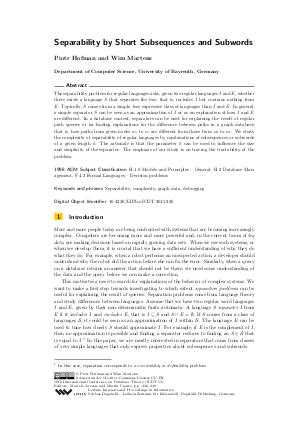Separability by Short Subsequences and Subwords
Authors Piotr Hofman, Wim Martens
-
Part of:
Volume:
18th International Conference on Database Theory (ICDT 2015)
Part of: Series: Leibniz International Proceedings in Informatics (LIPIcs)
Part of: Conference: International Conference on Database Theory (ICDT) - License:
 Creative Commons Attribution 3.0 Unported license
Creative Commons Attribution 3.0 Unported license
- Publication Date: 2015-03-19
File

PDF
LIPIcs.ICDT.2015.230.pdf
- Filesize: 479 kB
- 17 pages
Document Identifiers
Subject Classification
Keywords
- separability
- complexity
- graph data
- debugging
Metrics
- Access Statistics
-
Total Accesses (updated on a weekly basis)
0PDF Downloads0Metadata Views
Abstract
The separability problem for regular languages asks, given two regular languages I and E, whether there exists a language S that separates the two, that is, includes I but contains nothing from E. Typically, S comes from a simple, less expressive class of languages than I and E. In general, a simple separator $S$ can be seen as an approximation of I or as an explanation of how I and E are different. In a database context, separators can be used for explaining the result of regular path queries or for finding explanations for the difference between paths in a graph database, that is, how paths from given nodes u_1 to v_1 are different from those from u_2 to v_2. We study the complexity of separability of regular languages by combinations of subsequences or subwords of a given length k. The rationale is that the parameter k can be used to influence the size and simplicity of the separator. The emphasis of our study is on tracing the tractability of the problem.
Cite As Get BibTex
Piotr Hofman and Wim Martens. Separability by Short Subsequences and Subwords. In 18th International Conference on Database Theory (ICDT 2015). Leibniz International Proceedings in Informatics (LIPIcs), Volume 31, pp. 230-246, Schloss Dagstuhl – Leibniz-Zentrum für Informatik (2015)
https://doi.org/10.4230/LIPIcs.ICDT.2015.230
BibTex
@InProceedings{hofman_et_al:LIPIcs.ICDT.2015.230,
author = {Hofman, Piotr and Martens, Wim},
title = {{Separability by Short Subsequences and Subwords}},
booktitle = {18th International Conference on Database Theory (ICDT 2015)},
pages = {230--246},
series = {Leibniz International Proceedings in Informatics (LIPIcs)},
ISBN = {978-3-939897-79-8},
ISSN = {1868-8969},
year = {2015},
volume = {31},
editor = {Arenas, Marcelo and Ugarte, Mart{\'\i}n},
publisher = {Schloss Dagstuhl -- Leibniz-Zentrum f{\"u}r Informatik},
address = {Dagstuhl, Germany},
URL = {https://drops.dagstuhl.de/entities/document/10.4230/LIPIcs.ICDT.2015.230},
URN = {urn:nbn:de:0030-drops-49878},
doi = {10.4230/LIPIcs.ICDT.2015.230},
annote = {Keywords: separability, complexity, graph data, debugging}
}
Author Details
References
-
E. Botoeva, R. Kontchakov, V. Ryzhikov, F. Wolter, and M. Zakharyaschev. Query inseparability for description logic knowledge bases. In Principles of Knowledge Representation and Reasoning (KR), 2014.

-
J. Brzozowski and I. Simon. Characterizations of locally testable events. Discrete Mathematics, 4(3):243-271, 1973.

-
P. Buneman and W. C. Tan. Provenance in databases. In International Conference on Management of Data (SIGMOD), pages 1171-1173, 2007.

-
W. Craig. Three uses of the herbrand-gentzen theorem in relating model theory and proof theory. The Journal of Symbolic Logic, 22(3), 1957.

-
W. Czerwinski, W. Martens, and T. Masopust. Efficient separability of regular languages by subsequences and suffixes. In International Conference on Automata, Languages and Programming (ICALP), pages 150-161, 2013.

-
T. A. Henzinger, R. Jhala, R. Majumdar, and K. L. McMillan. Abstractions from proofs. In Principles of Programming Languages (POPL), pages 232-244, 2004.

-
E. Kopczynski and A. Widjaja To. Parikh images of grammars: Complexity and applications. In Logic in Computer Science (LICS), pages 80-89, 2010.

-
C. Lutz and F. Wolter. Foundations for uniform interpolation and forgetting in expressive description logics. In International Joint Conference on Artificial Intelligence (IJCAI), pages 989-995, 2011.

-
T. Masopust and M. Thomazo. On k-piecewise testability (preliminary report). CoRR, abs/1412.1641, 2014.

-
K. L. McMillan. Applications of craig interpolants in model checking. In Tools and Algorithms for the Construction and Analysis of Systems (TACAS), pages 1-12, 2005.

-
R. McNaughton. Algebraic decision procedures for local testability. Mathematical Systems Theory, 8(1):60-76, 1974.

-
R. McNaughton and S. Papert. Counter-free automata. The M.I.T. Press, 1971.

-
R. Paige and R. Tarjan. Three parition refinement algorithms. SIAM Journal on Computing, 16:973-989, 1987.

-
T. Place, L. van Rooijen, and M. Zeitoun. Separating regular languages by locally testable and locally threshold testable languages. In Foundations of Software Technology and Theoretical Computer Science (FSTTCS), pages 363-375, 2013.

-
T. Place, L. van Rooijen, and M. Zeitoun. Separating regular languages by piecewise testable and unambiguous languages. In Mathematical Foundations of Computer Science (MFCS), pages 729-740, 2013.

-
T. Place and M. Zeitoun. Separating regular languages with first-order logic. In Computer Science Logic - Logic in Computer Science (CSL-LICS), 2014.

-
L. Van Rooijen. Une approche combinatoire du problème de séparation pour les langages réguliers. PhD thesis, Université de Bordeaux, 2014.

-
S. Roy and D. Suciu. A formal approach to finding explanations for database queries. In International Conference on Management of Data (SIGMOD), pages 1579-1590, 2014.

-
I. Simon. Hierarchies of Events with Dot-Depth One. PhD thesis, Dept. of Applied Analysis and Computer Science, University of Waterloo, Canada, 1972.

-
I. Simon. Piecewise testable events. In Proceedings of GI Conference on Automata Theory and Formal Languages, pages 214-222. Springer, 1975.

-
J. Stern. Complexity of some problems from the theory of automata. Information and Control, 66(3):163-176, 1985.

-
L. Stockmeyer and A. Meyer. Word problems requiring exponential time: Preliminary report. In Symposium on Theory of Computing (STOC), pages 1-9, 1973.

-
W. C. Tan. Provenance in databases: Past, current, and future. IEEE Data Engineering Bulletin, 30(4):3-12, 2007.

-
Š. Holub, G. Jirśková, and T. Masopust. On upper and lower bounds on the length of alternating towers. In Mathematical Foundations of Computer Science (MFCS), Part I, pages 315-326, 2014.

-
P. T. Wood. Containment for XPath fragments under DTD constraints. In International Conference on Database Theory (ICDT), 2003. Full version, obtained through personal communication.

-
Y. Zalcstein. Locally testable languages. Journal of Computer and System Sciences, 6(2):151-167, 1972.

